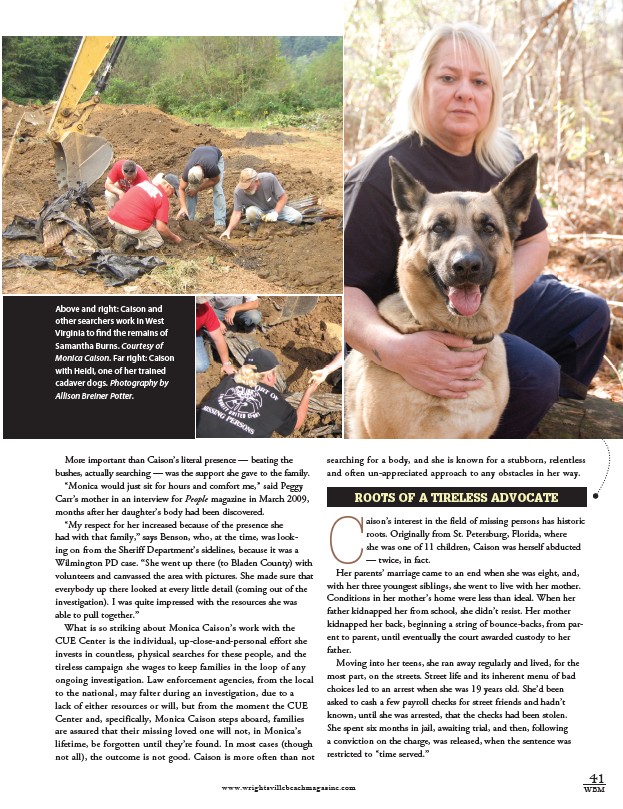
41
More important than Caison’s literal presence — beating the
bushes, actually searching — was the support she gave to the family.
“Monica would just sit for hours and comfort me,” said Peggy
Carr’s mother in an interview for People magazine in March 2009,
months after her daughter’s body had been discovered.
“My respect for her increased because of the presence she
had with that family,” says Benson, who, at the time, was looking
on from the Sheriff Department’s sidelines, because it was a
Wilmington PD case. “She went up there (to Bladen County) with
volunteers and canvassed the area with pictures. She made sure that
everybody up there looked at every little detail (coming out of the
investigation). I was quite impressed with the resources she was
able to pull together.”
What is so striking about Monica Caison’s work with the
CUE Center is the individual, up-close-and-personal effort she
invests in countless, physical searches for these people, and the
tireless campaign she wages to keep families in the loop of any
ongoing investigation. Law enforcement agencies, from the local
to the national, may falter during an investigation, due to a
lack of either resources or will, but from the moment the CUE
Center and, specifically, Monica Caison steps aboard, families
are assured that their missing loved one will not, in Monica’s
lifetime, be forgotten until they’re found. In most cases (though
not all), the outcome is not good. Caison is more often than not
searching for a body, and she is known for a stubborn, relentless
and often un-appreciated approach to any obstacles in her way.
Roots of a tireless advocate
Caison’s interest in the field of missing persons has historic
roots. Originally from St. Petersburg, Florida, where
she was one of 11 children, Caison was herself abducted
— twice, in fact.
Her parents’ marriage came to an end when she was eight, and,
with her three youngest siblings, she went to live with her mother.
Conditions in her mother’s home were less than ideal. When her
father kidnapped her from school, she didn’t resist. Her mother
kidnapped her back, beginning a string of bounce-backs, from parent
to parent, until eventually the court awarded custody to her
father.
Moving into her teens, she ran away regularly and lived, for the
most part, on the streets. Street life and its inherent menu of bad
choices led to an arrest when she was 19 years old. She’d been
asked to cash a few payroll checks for street friends and hadn’t
known, until she was arrested, that the checks had been stolen.
She spent six months in jail, awaiting trial, and then, following
a conviction on the charge, was released, when the sentence was
restricted to “time served.”
www.wrightsvillebeachmagazine.com WBM
Above and right: Caison and
other searchers work in West
Virginia to find the remains of
Samantha Burns. Courtesy of
Monica Caison. Far right: Caison
with Heidi, one of her trained
cadaver dogs. Photography by
Allison Breiner Potter.